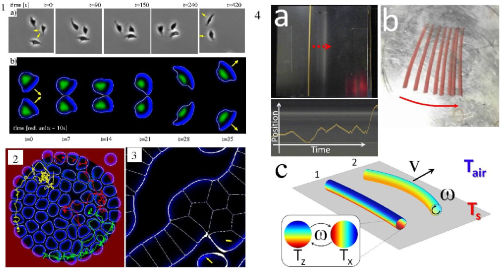Self-propelled motion of biological cells and polymeric fibers
Self-propulsion, i.e. self-organized motion in the absence of external forces, is an active research topic in non-equilibrium physics. Depending on the system, open questions span from the propulsive force generation and transfer over guiding mechanisms to collective effects in ensembles of self-propellers. The living realm presents plenty of examples, like crawling eukaryotic cells and swimming bacteria, having to move to survive and/or to fulfill their function. As living systems are complex (as social perception and/or biological regulation pathways are often involved in determining their behavior on multiple scales) several biomimetic and artificial systems have been proposed. Most of these are microswimmers, while artificial substrate-based propellers remain scarce.
In the first part I will give an introduction on substrate-based crawling motility of eukaryotic cells and survey our recent advances in modeling cellular motion. Using a modular approach, based on the phase field method to track the deformable and moving cells, the approach allows to describe, e.g., cell movement on structured substrates (with modulated adhesion or stiffness), as well as collective cell migration and motion in 3D confinement.
In the second part I present an artificial self-propeller, recently developed experimentally at the ICS (Strasbourg). It is based on a novel mechanism to propel elastic fibers along substrates, namely a thermally induced instability towards rolling motion. The mechanism is explained by an effective model combining elasticity of a rod with thermal advection-diffusion and the versatility of the effect is exemplified by investigating the self-propulsion, as well as simple motors and energy storage devices.

- Encounters (`collisions’) of crawling cells :
a) experiment on keratocytes (A. Verkhovsky)
b) model. 2) Dense ensemble of cells competing for voids. 3) A dynamic, tissue-like state of moving cells. 4) Self-propulsion of polymer fibers
[a) starch, b) silicone] by a thermally-induced instability, see c).